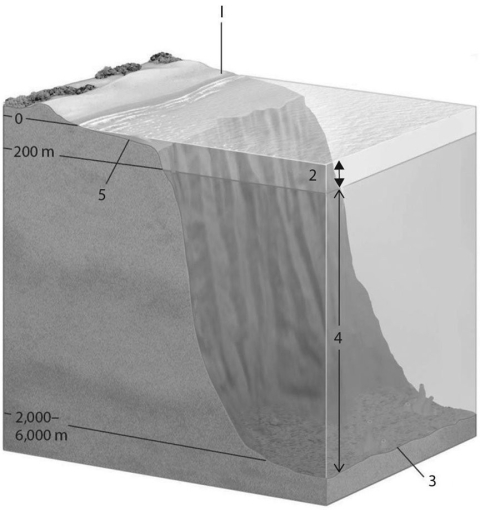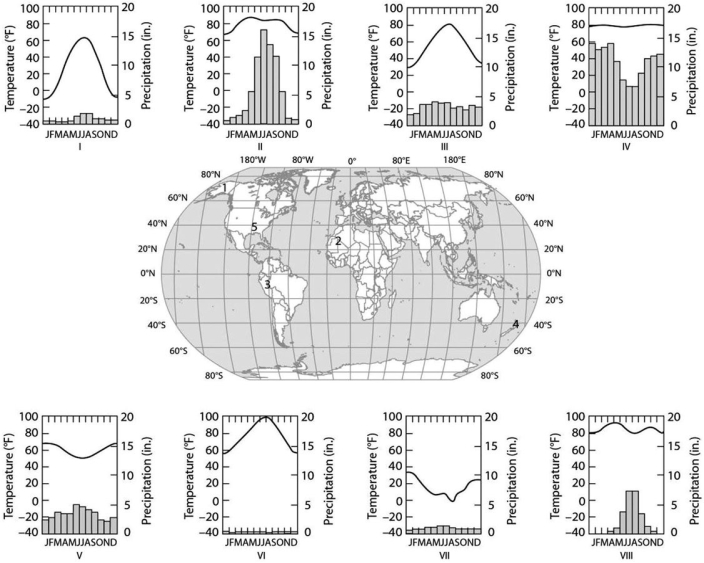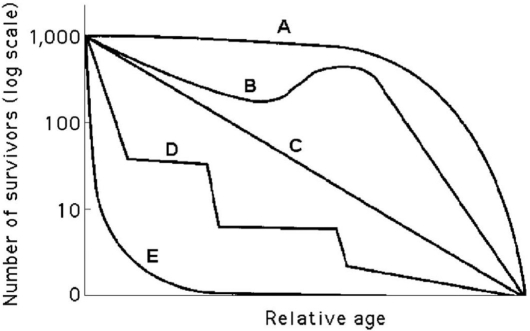A) community,ecosystem,individual,population
B) ecosystem,community,population,individual
C) population,ecosystem,individual,community
D) individual,population,community,ecosystem
E) individual,community,population,ecosystem
Correct Answer

verified
Correct Answer
verified
Multiple Choice
Using the logistic growth model,population growth would be represented by dN/dt =
A) ![]() .
.
B) rN.
C) rN (K + N) .
D) rN ![]() .
.
E) rN ![]() .
.
Correct Answer

verified
Correct Answer
verified
Multiple Choice
What is population dispersion?
A) the number of individuals in a population per unit area or volume
B) the pattern of spacing among individuals within a population's boundaries
C) the influx of new individuals from other areas through immigration
D) the defense of a bounded physical space against encroachment by others
Correct Answer

verified
Correct Answer
verified
Multiple Choice
Figure 40.2 shows a generalized cross section of the marine environment with various zones labeled with letters.Choose the number that best answers the question(s) .
 Figure 40.2
-Which zone has a condition of constant temperature?
Figure 40.2
-Which zone has a condition of constant temperature?
A) 1
B) 2
C) 3
D) 4
E) 5
Correct Answer

verified
Correct Answer
verified
Multiple Choice
A population of snowshoe hares was introduced to an appropriate habitat also inhabited by their natural predators in northern Canada.Which of the following graphs illustrates the growth over several seasons of the snowshoe hares?
A) ![]()
B) ![]()
C) ![]()
D) ![]()
E) ![]()
Correct Answer

verified
Correct Answer
verified
Multiple Choice
Please use the following information to answer the question(s) below.
The eight climographs in Figure 40.1 show yearly temperature (line graph and left vertical axis) and precipitation (bar graph and right vertical axis) averages for each month for some locations on Earth.Choose the climograph that best answers the question.
 Figure 40.1
-Which climograph shows the climate for location 3?
Figure 40.1
-Which climograph shows the climate for location 3?
A) II
B) III
C) IV
D) V
E) VI
Correct Answer

verified
Correct Answer
verified
Multiple Choice
Which of the following choices causes all of the others in creating global terrestrial climates?
A) differential heating of Earth's surface
B) Pacific and Atlantic ocean currents
C) seasonal changes in wind patterns
D) evaporation of water from the oceans
Correct Answer

verified
Correct Answer
verified
Multiple Choice
A particular mountain range is subjected to prevailing winds.Which of the following contributes the most to a drier climate on the leeward side of the mountain range?
A) air expanding and heating on the windward side of the range
B) air expanding and cooling on the windward side of the range
C) air expanding and heating on the leeward side of the range
D) air expanding and cooling on the leeward side of the range
Correct Answer

verified
Correct Answer
verified
Multiple Choice
A population's carrying capacity
A) may change as environmental conditions change.
B) can be accurately calculated using the logistic model.
C) generally remains constant over time.
D) increases as the per capita growth rate decreases.
Correct Answer

verified
Correct Answer
verified
Multiple Choice
 Figure 40.3
-Which statement best explains survivorship curve B?
Figure 40.3
-Which statement best explains survivorship curve B?
A) It is likely a species that provides little postnatal care but lots of midlife care for offspring.
B) This curve is likely a species that produces lots of offspring,but few are expected to survive.
C) There was a mass emigration of young to middle-aged individuals in this cohort.
D) Survivorship can only decrease;therefore,this curve could not happen in nature.
Correct Answer

verified
Correct Answer
verified
Multiple Choice
Coral reefs can be found on the southeast coast of the United States but not at similar latitudes on the southwest coast.Differences in which of the following most likely account for this?
A) sunlight intensity
B) ocean salinity
C) day length
D) ocean currents
E) precipitation
Correct Answer

verified
Correct Answer
verified
Multiple Choice
A certain species of pine tree survives only in scattered locations at elevations above 2,800 m in the western United States.To understand why this tree grows only in these specific places,an ecologist should
A) conclude that lower elevations are limiting to the survival of this species.
B) investigate the various biotic and abiotic factors that are unique to high altitude.
C) conduct soil analysis for growth supporting chemicals in the vicinity of these trees.
D) collect data on temperature,wind,and rainfall at several of these locations for a year.
Correct Answer

verified
Correct Answer
verified
Multiple Choice
Fire suppression by humans
A) will always result in an increase in species diversity in a given biome.
B) can change the species composition within biological communities.
C) will result in more small non-woody plants and fewer trees in savannas.
D) is necessary to maintain species composition in grassland and chaparral.
Correct Answer

verified
Correct Answer
verified
Multiple Choice
If a meteor impact or volcanic eruption injected a lot of dust into the atmosphere and reduced the sunlight reaching Earth's surface by 70% for one year,which of the following marine communities most likely would be least affected?
A) deep-sea vent
B) coral reef
C) intertidal
D) pelagic
E) estuary
Correct Answer

verified
Correct Answer
verified
Multiple Choice
Which of the following statements best describes the effect of climate on biome distribution?
A) Average annual temperature and precipitation are sufficient to predict which biome will be found in a certain area.
B) Seasonal climate variation is not a limiting factor in biome distribution in areas with the same annual climate patterns.
C) Both average climate and the pattern of climatic variation are important in determining the nature of an area biome.
D) Temperate forests and grasslands are not the same biomes solely because of the variances in sunlight received.
E) Correlation of climate with biome distribution is sufficient to determine the cause of terrestrial biome patterns.
Correct Answer

verified
Correct Answer
verified
Multiple Choice
Which variables define the ecological life history of a species?
A) the age at which reproduction begins,frequency of reproduction,and the number of offspring for each reproductive episode
B) the ratio of females to males,the length of the breeding season,and the number of offspring for each reproductive episode
C) the number of offspring produced over a lifetime by a breeding pair and the survivability of the offspring
D) timing breeding sessions with optimal environmental conditions and the number of offspring produced during each breeding session
E) the amount of parental care given after birth,the number of reproductive episodes per year,and the number of years females are capable of producing viable offspring
Correct Answer

verified
Correct Answer
verified
Multiple Choice
Which of the following groups would be most likely to exhibit uniform dispersion?
A) red squirrels,a type of animal that actively defends its territories
B) cattails,plants that grow primarily at edges of lakes and streams
C) dwarf mistletoes,plants that parasitize particular species of forest trees
D) moths in cities throughout North America that are active at night
E) lake trout,fish that seek out cold,deep water high in dissolved oxygen
Correct Answer

verified
Correct Answer
verified
Multiple Choice
The main reason that polar regions are cooler than the equator is that
A) there is more ice/glaciers at polar regions.
B) sunlight strikes the poles at a lower angle.
C) the polar regions are farther from the sun.
D) the polar regions' atmosphere is thinner.
E) the poles are always tilted away from the sun.
Correct Answer

verified
Correct Answer
verified
Multiple Choice
In July 2008,the U.S.population was approximately 302,000,000.If the estimated 2008 growth rate was 0.88%,approximately how many total Americans were there in July 2009?
A) 2,700,000
B) 5,500,000
C) 303,000,000
D) 304,700,000
E) 2,710,800,000
Correct Answer

verified
Correct Answer
verified
Multiple Choice
Which marine zone is expected to have the lowest rates of primary productivity (photosynthesis) ?
A) pelagic
B) abyssal
C) photic
D) limnetic
E) intertidal
Correct Answer

verified
Correct Answer
verified
Showing 61 - 80 of 93
Related Exams